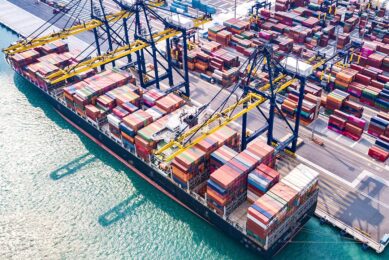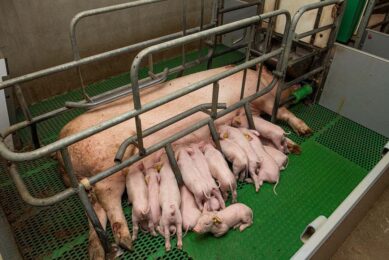Why cooperative Lar wants to stay ‘clean’

Brazil’s animal protein industry comprises of various large cooperatives. One of the best known is Lar, headquartered in Medianeira, PR, in the country’s south. With African Swine Fever ravaging Asia, opportunities are plentiful to promote its own products on a wider scale.
Inside the control room of the Santa Helena feed plant a large green smiley hangs on the wall. It looks out over 4 employees studying their screens. “It’s a sign that the plant is very clean,” says Carlos Eduardo Varnier (34), manager of the feed plant. “We have staff who go through the plant regularly to make sure that everything is nice and clean. Then we give it a rating. Today everything was just fine.”
Cleanliness and good biosecurity are 2 of the main principles at Lar, one of Brazil’s largest agro-industrial cooperatives. Now more than ever, the cooperative realises that keeping things clean and tidy – and thoroughly so – can make all the difference between profit and loss. For a few years now, times for Brazil’s agro-industry have not been great, but with African Swine Fever causing tremendous losses in Asia, export opportunities are emerging. The disappearance of millions of pigs in China will lead to an increased demand for pork as well as other sources of animal protein, like poultry, and it is poultry feed that this particular plant produces.

Recent spur in expansion
Although the cooperative has already existed for 55 years, recently Lar has begun gearing up extensively in southern Brazil. Varnier’s plant was founded with one feed production line in 2002 and has expanded over the years to reach 4 in 2016. All the feed production lines were set up in cooperation with the Netherlands-based feed mill manufacturer Van Aarsen and its Brazilian distributor Schneider. Lar chose to work with Van Aarsen because of its robust advanced feed production lines and good technical support.
Varnier has worked for the cooperative for 14 years and been a manager at the Santa Helena plant for just under 2 years. There will be more expansion of the feed plant to come, he says. Outside the plant at the time of our visit, construction work on new warehouse for raw materials was in progress, while more optimum use of the plant should ensure that further growth is possible.

Forecast production levels
A total production volume of 780,000 tonnes of complete feed for poultry (both broilers and broiler breeders) is envisaged for 2019, and it is projected that the plant should to be able to produce 900,000 tonnes in 2020.
Some smaller farms indeed do everything, from corn production to keeping livestock. The larger members focus only on growing crops.” – Carlos Eduardo Varnier, manager of the feed plant.
Biosecurity within
Inside the plant indeed everything looks meticulous, with hardly any signs of dust lying around. Staff wear protective clothing and helmets inside, walkways and storage areas are clearly defined on the floor and the rooms are kept tidy.
Feed production
The most important raw materials are soybeans and corn, all grown locally. In total 36 ingredients are added, creating 13 different rations for the birds – with 8 types for broilers and 5 for layers. The corn is brought in at the facility via a different entrance to the soybeans and is then transported diagonally to the feed mill by a wire connection.
Co-op members
Varnier explains that the majority of Lar’s business is concentrated around the poultry business. The cooperative works with 1,500 poultry farm members altogether, amounting to some 20 million birds in a 150 kilometre radius around the feed plant.
The Santa Helena plant obtains its feed raw materials from over 10,000 affiliated farmers from surrounding states like Paraná, Santa Catarina and Mato Grosso do Sul – and even farmers from neighbouring Paraguay supply the Santa Helena plant. The larger supplying farms have specialised, Varnier explains. “Some smaller farms indeed do everything, from corn production to keeping livestock. The larger members focus only on growing crops.”
All in all, the message is clear. Given that southern Brazil has a vast potential for growing crops and providing animal protein for the entire world, the opportunities had better be well planned and the facilities properly protected. Preferably as cleanly as possible.
Lar cooperative: Much more than just poultry‘Lar’ is a Portuguese word meaning ‘home’ or ‘my place’. The Lar cooperative is one of many found in Brazil, as a large part of the country’s agriculture revolves around cooperatives. The Lar cooperative, headquartered in Medianeira, Paraná, has 11,000 members and roughly 13,000 employees. Covers entire production chain The cooperative covers the entire production chain, from multiplication and feed production to its own slaughterhouses, supermarket brands, large retail shops and even a few gas stations.  A Lar supermarket ìn São Miguel do Iguaçu. The brand The cooperative sells own brand products and other traditional Brazilian brands in its supermarkets. Lar also buys products from elsewhere (even abroad). These are marketed under the Lar brand which has a name for good quality produce. The Lar supermarkets are found only in southern Brazil, although the Lar brand is sold throughout the country and is even exported to more than 74 countries worldwide. The projected turnover in 2019 is R$ 6.95 billion (€ 1.58 billion).  Pork for sale under the Frimesa brand in the Lar supermarket. Swine production In terms of its swine production, Lar is integrated. The cooperative has 21,000 sows and an additional 4,000 sows through its members, producing 650,000 piglets in 2019. However, these are sent to the slaughterhouses and processing plants of Frimesa, another cooperative in southern Brazil. The products from these plants are then sold in Lar supermarkets as well as other supermarkets throughout the country. Feed & beef Apart from the feed mill in Santa Helena, the cooperative owns another two feed plants: with one for pig feed and one for dairy and beef cattle. The cooperative has no beef cows of its own but does have 6,000 dairy cows. In 2018 they produced 25.9 million litres of milk – while for 2019 a total volume of around 22.2 million litres has been estimated. |
 Beheer
Beheer








 WP Admin
WP Admin  Bewerk bericht
Bewerk bericht